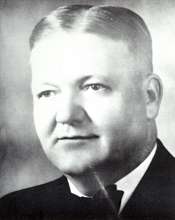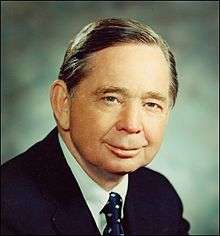Oklahoma's 3rd congressional district
| Oklahoma's 3rd congressional district | |
|---|---|
|
Oklahoma's 3rd congressional district - since January 3, 2013. | |
| Current Representative | Frank Lucas (R–Cheyenne) |
| Distribution |
|
| Population (2000) | 690,131 |
| Median income | 32,098 |
| Ethnicity |
|
| Cook PVI | R+27[1] |
Oklahoma's Third Congressional District is the largest congressional district in the state, covering an area of 34,088.49 square miles. The district is bordered by New Mexico, Colorado, Kansas, and the Texas panhandle. Altogether, the district includes (in whole or in part) a total of 32 counties.
As of 2015, the district is represented by Republican Frank Lucas.
For most of the time prior to 2003, the 3rd district was located in southeastern Oklahoma, an area known as Little Dixie. It was the district of Carl Albert, Speaker of the House from 1971 to 1977. Prior to 2003, most of the territory now in the 3rd district was in the 6th district.
Geography
The district borders New Mexico to the west, Colorado and Kansas to the north, and the Texas panhandle to the south. To the far west, the district includes the three counties of the Oklahoma Panhandle (Cimarron, Texas, Beaver), and also Harper, Ellis, Woodward, Woods, Major, Alfalfa, Grant, Garfield, Kay, Noble, Osage, Pawnee, Creek, Payne, Lincoln, Logan, Kingfisher, Blaine, Canadian, Dewey, Custer, Rogers Mills, Beckham, Washita, Caddo, Kiowa, Greer, Harmon, and Jackson.
Some of the principal cities in the district include Guymon, Ponca City, Enid, Stillwater, Yukon, Guthrie, Sapulpa and Altus. It also includes portions of Oklahoma City and Tulsa.
Demographics
Half of the district's inhabitants are urban and 3 percent of adults working in the district use public transportation, ride a bike, or walk.[2] The district's population is 5 percent Latino and 3 percent foreign-born.[2]
Results from recent statewide elections
| Year | Office | Results |
|---|---|---|
| 2000 | President | Bush 66% - 34% |
| 2004 | President | Bush 72% - 28% |
| 2008 | President | McCain 73% - 27% |
| 2012 | President | Romney 74% - 26% |
| 2016 | President | Trump 74% - 21% |
Politics
The political success of the Republican party in the region is tied to the state's settlement patterns. Northwest Oklahoma was settled out of Kansas while southeast was settled by southerners that brought with them Democratic traditions.[3]
The Great Depression hurt the GOP,[3] but it has since regained its place in the state, and the growing social conservative bent in the state has allowed it to overtake the Democrats. It is now one of the most Republican districts in the nation.
George W. Bush received 72 percent of the district's vote in 2004.
List of representatives
Historical district boundaries

See also
References
- ↑ "Partisan Voting Index – Districts of the 115th Congress" (PDF). The Cook Political Report. April 7, 2017. Retrieved April 7, 2017.
- 1 2 Representative Frank Lucas, That's My Congress (accessed June 1, 2010).
- 1 2 Gaddie, Ronald Keith. Republican Party, Encyclopedia of Oklahoma History and Culture (accessed February 11, 2010).
- Martis, Kenneth C. (1989). The Historical Atlas of Political Parties in the United States Congress. New York: Macmillan Publishing Company.
- Martis, Kenneth C. (1982). The Historical Atlas of United States Congressional Districts. New York: Macmillan Publishing Company.
- Congressional Biographical Directory of the United States 1774–present
| U.S. House of Representatives | ||
|---|---|---|
| Preceded by Massachusetts's 9th congressional district |
Home district of the Speaker of the House January 21, 1971 – January 3, 1977 |
Succeeded by Massachusetts's 8th congressional district |
Coordinates: 36°00′N 98°30′W / 36.0°N 98.5°W
.tif.png)
.jpg)







